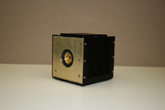
We're always looking for practical applications of what we do. Here's one from from Makezine:
"As you folks know--all too well, I'm sure--it is extremely difficult to collect blood from a wild whale without injuring or killing it in the process. However, and as even a child can tell you, the next best thing to live whale blood is live whale snot. Turns out it spews from their blowholes when they exhale, so the process is really very simple:
- Find whale.
- Hold petri dish over blowhole to intercept spout.
- Return to lab, enjoy sample.
Step 2 is actually the hard part. And although your first instinct may be to just jump in your rowboat, paddle out to a whale pod, lean way out over the side with your sample container, and wait, that's actually not as safe as it might sound. Each year, untold millions of scientists die attempting this maneuver. Their sun-bleached bones litter beaches all along the Pacific coast.
Enter Dr. Karina Acevedo-Whitehouse, of the Zoological Society of London. Her recent paper in Animal Conservation(abstract), irresistibly entitled "A novel non-invasive tool for disease surveillance of free-ranging whales and its relevance to conservation programs," introduces the ground-breaking methodology of strapping a petri dish to a toy RC helicopter and flying it into the spout. This landmark work stands not only to revolutionize our understanding of whale disease, but to save countless lives, and establishes Dr. Acevedo-Whitehouse as a serious contender for this year's (Ig) Nobel "Prize."
[via The Thoughtful Animal]








